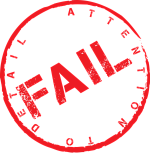 Physician Burnout - 7 Ways Your Physician Wellness Committee will Fail
Physician Burnout - 7 Ways Your Physician Wellness Committee will Fail
So very few organizations make an effort to address physician burnout proactively … it is an industry wide blind spot. We are all so busy putting out the daily fires of patient care and ceaseless organizational change that doing something for the people in the system never makes it onto your punch list.
If you do not address workplace stress and physician burnout proactively you are doomed ...
... to receive lower patient satisfaction and quality scores
- higher error rates and malpractice risk
- be forced to deal with disruptive physician behavior
- and higher than normal physician and staff turnover
What if you have a Physician Wellness Committee?
You are not out of the woods by any means. Your organization is one of the 10% who are making an attempt to address physician burnout proactively. You are one of the lucky ones.
And your Physician Wellness Committee will fail if you don't understand these 7 critical errors I see organizations make over and over again.
Do not fall into these traps!
==================================
Physician Wellness Champion Training
Our Quadruple Aim Physician Leadership Retreat
Use this Link for Full Details
==================================
7 Ways Physician Wellness Committees Often FAIL
1) No leadership support
Any attempt to address physician burnout without CEO, CMO and COO support will fail. Without their obvious verbal and budgetary support of your burnout prevention efforts - they are just humoring you.
They will give lip service to letting the most concerned of you get together for a monthly meeting ... and yet when it comes time to write a check for a prevention project ... what looked like support quickly, vanishes.
This is a consequence of a leadership capitulation at the highest level. The leaders are sick and tired of physician’s whining and have given up on the possibility of things being different. They will let you meet as much as you want as long as it doesn't cost money. They have zero faith that your Wellness Committee will make any meaningful changes.
This administration stance that is hostile to physician wellbeing (whether they will cop to it or not) is present at approaching 90% of organizations in my experience.
Make sure you have leadership support at the highest level ... or you are doomed to an ineffective insurgency against an opposition that has the high ground.
2) The NAME for gosh sakes

Do NOT name your committee the "Physician Wellness Committee". Here's why.
Wellness is a completely foreign concept to physicians. We are taught and conditioned to diagnose and treat disease. If you seat a "Wellness Committee", the only time your doctors will ever use the word "wellness" in their work week is when they are saying the actual name of the committee.
Here is a more effective name:
The Burnout Prevention Working Group
Let your docs stay in their comfortable disease fighting role
- The disease is Physician Burnout
- The Risk Factor is Stress
- We are a "Working Group" - we do work ... not a Committee - where we have meetings
This simple name change can create focus and momentum from the start.
3) Searching for best practices
Taking time and energy to research best practices is a complete waste of time.
When you do find a group that is getting traction against physician burnout, you will quickly find their program is unique. When you have seen one burnout prevention program ... you have seen one.
In today's healthcare industry, most groups are a conglomeration of formerly independent provider organizations - spread out over a wide geographic area - each with their own history, culture, specialty makeup and, until recently, their own individual compensation formulas.
You must focus your working group on addressing your unique issues from the start. You can very easily waste 12 – 18 months and all of your budget on this search for someone else's solution you can simply mimeograph when that is magical thinking at its finest.
4) Being a Savior vs. a Surveyor
Most Physician Wellness Committees will meet for months to try to figure out what to do for their people. There is a subconscious urge to be the savior and come up with the right answer. It is the same subconscious urge buried in every patient encounter. Physicians are programmed to figure out the problem, find a solution and tell everyone what to do (Diagnose and Treat)
This is a complete waste of time unless you FIRST create a feedback loop with your front line providers.
Rather than try to figure it out ... ask your people what they need
It is that simple. This urge to come up with the right answer is a classic piece of physician programming. Do not fall victim to it.
When I say "ask your people what they need" I am NOT talking about the typical 140 item physician satisfaction surveys that cost $1M and still yield no actionable answers. These abominations actually make burnout and stress levels worse and send the message, "we would rather spend money on surveys than on helping you out."
Think about it ... asking a busy doc to fill out a 140 item physician engagement survey ... what message does that send? Really? 140 items for gosh sakes and I know I will never hear about the results again.
Your burnout prevention working group can send a seven item survey that will give you actionable results in days.
Here are the questions we recommend
1) What is your level of satisfaction with your practice here at MegaHealthCorp
- on a 1 - 10 scale?
2) What is the #1 source of stress in your work day?
3) What is the #2 source of stress in your work day?
4) What is the #3 source of stress in your work day?
5) How would you describe the culture around here in one sentence?
6) What would you like that culture to be?
7) Anything else?
All you have to do is take their answers to the top stressors, compute a weighed average and you have your burnout prevention project list
5) No budget and no admin support
Most burnout prevention working groups are given no protected time, no pay, no administrative support and no budget. This is another way to know your C-suite is just humoring you rather than actually caring about your health and happiness.
Ideally, physician members of the working group have the following
- time off of patient care duties - protected time - for working group activities
- pay for working group activities equivalent to what they earn when seeing patients
- administrative support for the working group including meeting facilitators, project managers and administrative assistant support.
Without this level of investment, your organization is effectively strangling the good intentions of the
doctors on the working group.
An enlightened CFO should be your biggest supporter here. Remember when we lower stress and burnout levels we increase patient satisfaction and quality and decrease malpractice risk and turnover. That combination should raise the eyebrows of any intelligent CFO.
6) Failure to fill the educational black hole
 There is a MASSIVE HOLE in the education of all the people in your organization who touch patients in the course of their work day.
There is a MASSIVE HOLE in the education of all the people in your organization who touch patients in the course of their work day.
Your doctors and staff learned NOTHING about stress, stress management and burnout prevention in their training. Doctors, NP’s, PA’s, nurses, MA’s, reception, administrators ... everyone is at risk.
Burnout is the giant sucking sound of this hole in our education.
SO the first responsibility of the Burnout Prevention Working Group is to coordinate a system wide education program.
This is the responsibility of the employer and a first step for the burnout prevention working group because even now these topics are not being covered in healthcare training programs.
Without basic burnout prevention training you have no foundation for additional working group initiatives.
Burnout Prevention training also sends a number of powerful, culture changing messages
- we acknowledge this work is stressful
- we acknowledge that burnout is an issue and we want to help you avoid it
- we are providing this training because we care about you too ... not just the patients
- we can talk about stress and burnout rather than treating the subjects as taboo
- it is OK to ask for help and support
We have created two comprehensive training resources for entire organizations:
i) The Burnout Proof Live Workshop
ii) Our self help manual: "Stop Physician Burnout"
Bulk purchases are available at substantial discounts
7) Not allowing your Burnout Prevention Working Group to participate in system design
Have you ever seen a new process come down from administration that made no sense at all? From your position in the front lines it is clear they didn't ask a doctor about this half baked idea along the way. I know you have experienced this.
And your suspicions are absolutely correct. This process WAS designed in a physician leadership vacuum. At no point along the way was a physician given the chance to influence the design of this process. Your burnout prevention working group is a natural source of this input for the organization.
One of the main causes of physician burnout is the stress of the systems in which we see patients. There are three systems working in parallel in most practice situations.
- Patient Flow
- Information Flow
- Cash Flow
If your physicians do not have the ability to give input as these systems are designed, you are putting your people under more stress than is necessary.
In an ideal world, a proactive physician burnout prevention program gives more influence on the design of the workplace flow systems to physicians
Avoid these Seven Physician Wellness Committee FAILS
Use our four-part Quadruple Aim Blueprint Strategy to launch your Burnout Prevention Working Group with immediate impact.
PLEASE LEAVE A COMMENT:
What wellness committee successes and failures have you seen.

